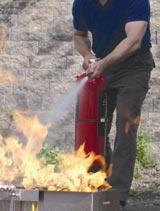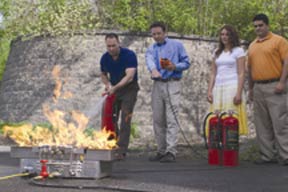
Beyond Compliance
Comprehensive fire extinguisher training programs create a safer workplace.
- By Simon Balint, Ryan O'Donnell
- Jun 12, 2007
 AS many are well aware, OSHA requires that employees be educated in the use of fire extinguishers every year. Specifically, OSHA 29 CFR 1910.157(g) states: "Where the employer has provided portable fire extinguishers for employee use in the workplace, the employer shall also provide an educational program to familiarize employees with the general principles of fire extinguisher use and the hazards involved with incipient stage fire fighting."
AS many are well aware, OSHA requires that employees be educated in the use of fire extinguishers every year. Specifically, OSHA 29 CFR 1910.157(g) states: "Where the employer has provided portable fire extinguishers for employee use in the workplace, the employer shall also provide an educational program to familiarize employees with the general principles of fire extinguisher use and the hazards involved with incipient stage fire fighting."
While offering fire extinguisher education to your employees ensures regulatory compliance, there are also a number of important reasons why a comprehensive fire extinguisher training program should be a central element of any complete work safety regimen. Fires have a nearly unmatched potential for loss of property and loss of life. Nationwide, fires account for more than $10 billion in property loss each year and result in more deaths than all natural disasters combined.1
In 2005, there were more than 80,000 non-residential structural fires at businesses, institutions, and educational and public facilities, with almost one person killed every weekday by fire at work.2 But while fires continue to pose a real and significant threat, there exist readily available tools at virtually every work site that can be used to combat this danger. Portable fire extinguishers are an almost universal tool that in the hands of a properly trained individual can effectively address most fire situations. The key opportunity and challenge is to develop ways to educate employees about the fire safety resources that are available at their place of work and to train them how to properly identify, assess, and respond to a fire situation.
Why Fire Extinguisher Training is So Important
In most basic terms, fire extinguishers work! In fact, 94 percent of all fires are extinguished by portable fire extinguishers.3
Fire extinguishers are an important safety tool located throughout the work site, but like any tool, proper training is needed to support safe and effective usage. Trained individuals are 250 percent more effective in extinguishing fires than those who are unfamiliar with fire extinguishers.4
Trained employees are given the confidence they need to respond to an emergency situation and are more likely to remember and follow the specific emergency protocols their company has established. Portable fire extinguishers are designed for insipient stage fire fighting. Fundamentally, fire training is both about how and when to utilize portable fire extinguishers. Trained employees will be better able to assess fire risk so as to determine when the use of the fire extinguisher is appropriate and when it is not.
Confronted with a fire emergency, untrained individuals are more likely to use the wrong type of portable extinguisher or may even attempt to fight a fire with "homemade" tools such as jackets, buckets of water, or potted plants. This type of response often only increases the scope of the fire situation and heightens the risk to them and others. Untrained employees can enhance the threats to themselves if they do try to take action but do not fully understand how to identify and use the proper tools that are available.
Employee safety is always the first concern, and with this in mind, some safety officers institute an evacuation-only policy rather than look at ways to have employees be prepared to use the fire extinguishing aids that are available throughout the workplace. A blanket evacuation-only emergency plan can fail to recognize the realities of many fire incidents. In an actual fire situation, evacuation is not always an option. Extinguishers can be used to create a means of egress when paths are otherwise blocked by fire. They also can be used to reach or respond to personnel in immediate danger.
Fire extinguishers can play a key role in minimizing business losses. By combating fires before they become large-scale emergencies, property losses and downtime can be greatly reduced or eliminated.
Finally, fire extinguisher training is a fundamental life safety skill that can extend well beyond the immediate job site. Four out of five fire-related injuries and deaths occur in homes, and a fire extinguisher training program will enhance the overall safety of your employees, both on and off the clock.
Elements of a Comprehensive Training Program
Each fire extinguisher training program should be tailored to the specific realities of the given work site and adjusted within each organization for different groups of personnel, depending on the threats they face. Still, a comprehensive program should include several common elements.
1. Describe the basic sources of fire and various ways of stopping the combustion process. Fires are a chemical reaction that occurs when fuel, oxygen, and an ignition source combine. Fire extinguishers work by removing one or more of these sources with different extinguishers working in different ways.
2. Describe the types (classes) of fires and the extinguishers that should be used in each situation. Many fire extinguishers are designed for use on specific types of fires. Using a fire extinguisher that does not match the class of fire at hand can actually increase the fire hazard and endanger both the user and those around him.
3. Teach how to identify an extinguisher, including the class and size of fire it is designed to combat. Help your employees identify the actual extinguishers that can be found around their place of work. Have employees point out and pick up the extinguishers they could be using in an emergency situation.
4. Focus on assessing and measuring fire risks. Because portable fire extinguishers are designed for insipient stage firefighting, employees should be familiar with how to properly assess a fire situation. Many metrics can be used. One, often cited, is that individuals should not use a portable fire extinguisher to combat fires larger than themselves. Other considerations used in making a "fight or flight" assessment include the location of the fire; levels of heat, smoke, or fumes; and the availability of sufficient egress routes.
5. Ensure employees understand how the use of fire extinguishers fits into the overall emergency response protocols for your organization. Many response plans require that the first step in a fire situation is to provide an alert. The familiar P.A.S.S. technique (Pull, Aim, Squeeze, Sweep) could be modified to A.P.A.S.S.--with "Alarm" (yelling fire, calling safety personnel, or pulling an alarm) as the first true action step.
6. Most important, train employees on the operation of fire extinguishers. Nothing compares to actual practice. Hands-on training is by far the most successful way to familiarize someone with extinguisher usage. Watching a video or providing a classroom demonstration is no substitute for seeing a fire, reaching for an extinguisher, pulling the pin, and squeezing the trigger yourself. Hands-on training engages trainees because they are able to put the learning elements of the classroom into practice, and new learning points are uncovered through the hands-on experience. Most employees who haven’t actually used an extinguisher are amazed at how little discharge time one has. A standard 10lb ABC extinguisher provides just 20 seconds of discharge. Training not only builds confidence, it also breaks down overconfidence. Hands-on training helps employees further assess risk and appreciate the limits of portable extinguishers.
Tips for Hands-on Training
Hands-on training provides numerous opportunities for teaching lessons of effective fire extinguisher usage. Below are some ways to further engage and educate employees.
1. Simulate a variety of different fire situations, including different types of fires or fire level difficulties.
2. Have employees work with varying sizes of extinguishers so they understand the potentials and limits of each.
3. Teach employees to maintain proper distance from fires depending on the size of extinguishers used and the type of fire. Also, demonstrate how to move away from a fire properly once you believe it has been controlled.
4. Teach employees to check the pressure gauges and test extinguishers before approaching a fire. An excellent learning tool can include having trainees pick from multiple training extinguishers where one or more are not fully charged.
Keep class sizes small, ideally fewer than 20 at a time, so as to enable everyone to participate, ask questions, and stay engaged. Allow opportunities for all trainees to extinguish the fire with chances to refine their techniques and try again if they fail at first.
A well-executed fire extinguisher training program offers much more than a means of regulatory compliance. A comprehensive program that includes both classroom and hands-on education where employees understand the risks, challenges, and opportunities in facing a fire emergency will truly engage employees in the fire safety policies of the company, creating a safer workplace for all.
References
1. NFPA, Fire Loss in the United States During 2005 Full Report
2. Ibid. NSC, 200 killed by work related fires in 2005
3. NAFED
4. NAFED
This article originally appeared in the June 2007 issue of Occupational Health & Safety.